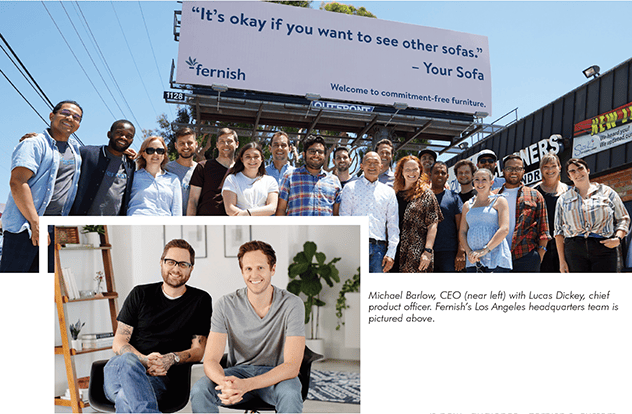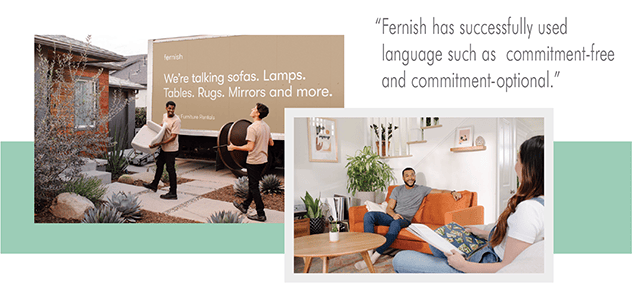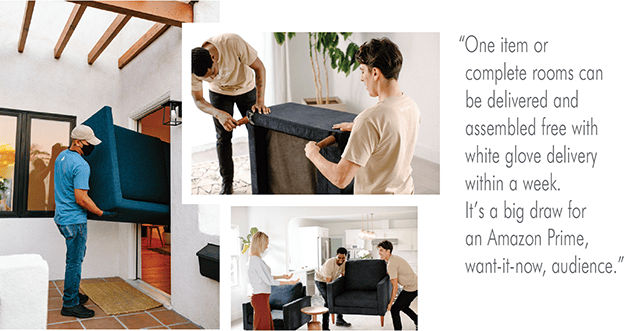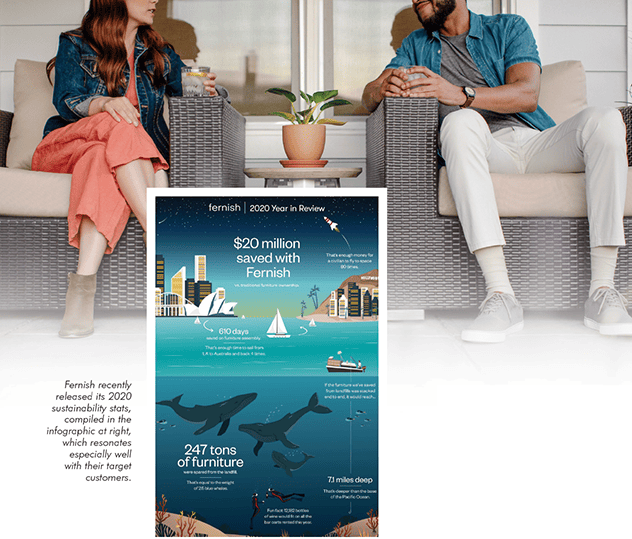
Online
furniture retailer Fernish targets a young mobile audience that sees traditional furniture retail
as clunky, costly
inefficient, time-
consuming and hassle intensive.
Online furniture retailer Fernish got its start just four years ago when Michael Barlow, CEO of Fernish, and his business partner Lucas Dickey, chief product officer, started thinking about the furniture business.
An important part of
our core purpose is
to keep furniture out of landfills via our
refurbishment and
recycling process.
|
“The idea of furnishing a temporary home with permanent furniture seemed to us to be clunky, costly, inefficient, time-consuming and hassle intensive,” said Barlow. “Creating a home environment in a new city should be effortless. Lucas and I observed how we and other young, mobile consumers were having difficulty setting up and furnishing homes. The problem had to do with moving to rented spaces—apartments or houses—along with roommates, short-term relationships and job situations.
“So, we came up with an idea for a service economy product that would solve all the challenges associated with buying, owning, moving, selling, storing and disposing of furniture. The Fernish rental model came out of our personal experiences, pain points and mobility challenges.”
In 2017, the partners didn’t know much about traditional lease-to-own companies. “Other players in the furniture rental business,” Barlow said, “had developed financing alternatives, but nearly 100 percent of the people in the demographic we targeted had never considered or even heard of furniture rental as an option. Fernish doesn’t try to compete with legacy furniture rental companies, but we’ve seen a huge opportunity to take share from brick-and-mortar retail companies that haven’t evolved a service economy experience.
Target Customers
“Our customers often consider buying from flatpack, assemble-it-yourself retailers like Ikea, or from more aspirational lifestyle stores such as West Elm. They are often unsure about how long they will be living in a location or how roommates will share costs. Many don’t feel comfortable committing to pay all that money upfront, then figuring out how to dispose of it should a roommate move out early or at the end of a lease.”
Furniture World asked Barlow to give additional reasons why his millennial customers might forgo purchasing a promotionally-priced sofa or something of higher quality from a local store.
“People choose us for the convenience and flexibility we provide,” he replied. “Convenience from Fernish means that shoppers can get everything from one place. We don’t have 70,000 sofas or 15,000 desks to choose from. The selection is curated to about a dozen. They can choose to buy one item or complete rooms that can be delivered and assembled free with white glove delivery within a week. It’s a big draw for an Amazon Prime, want-it-now, audience. Fernish’s customers who are not satisfied with their choices within three days of delivery can exchange them for something else. There’s no extra cost.”
They are attracted to the flexibility of monthly payment options. These include rental terms from two to 12 months. “The majority of our customers tie the lease of their furniture to the term of their apartment lease. If they like the furniture and decide to stay in Dallas, Los Angeles or Seattle, there is a purchase option. They just pay off the difference between what was already paid and the retail value. But if they are moving to another city, they can avoid the hassle, moving costs and uncertainty. We just pick up the furniture.”

At the end of the lease period there are three choices described on the fernish.com website: extend the lease for another two-to12-month term, swap items or keep them. For customers who move somewhere else in the same area, Fernish picks up and moves their leased furniture at no charge.
Aiding The Circular Economy
Regarding product quality, Barlow adds, “Fernish provides quality products that are aspirational. We don’t believe in putting $400 sofas into circulation because they’re going to end up in a landfill within a year. Our customers understand that they get what they pay for. They are ready to “hashtag adulting”—move on up from budget intro-level product that will need to be given away, thrown on the curb or sold on Craigslist.
Our customers often consider
buying from flatpack, assemble-it-yourself retailers like Ikea or from more aspirational lifestyle stores such as West Elm.
|
Bite-size monthly payments are certainly helpful. It’s part of our service. We are not a lender that offers lease-to-own financing to customers who have poor credit. Pricing is comparable to brick and mortar retailers, and we can make a good margin because we refurbish and restore product, then sell it more than once. But from a consumer’s perspective, it’s all like-new because we don’t offer white linen covers on low-density foam sofas. Everything that comes back is cleaned and tested. Damaged cushions are replaced.
“Target has stayed ahead of this trend by starting to segment their home brands. Each one has a different voice,” she noted. “They're not trying to offer the widest selection and be all things to all customers. I think it's a really smart move.”
“We can strip down metal frame sofas, dry clean or dry soap components and replace covers. We’ve built our entire team around providing this kind of operations and logistics.” Barlow said that Fernish has a circular economy perspective as compared to a traditional furniture retailer that operates on a forward deployment model.
“We have a cool trademark and a process associated with it called Circular Ready™. Our warehouses are set up like circles. Ingress, egress, quarantine, refurb, stocking and staging. The product flows all the way through, managed by our in-house ERP asset management system. We understand the game of furniture Tetris that manages products coming in from suppliers and customers, then going back out for delivery. We’re able to match those flows quickly to dynamic advertising and get product out the door in terms of warehouse throughput and logistics.

“The challenge we face is to shift mindshare away from purchasing at retail to a flexible rental economy solution. The customers we target are primarily 22- to 34-year-olds who are attracted to Crate & Barrel and CB2 style products and have moved at least once. They understand the pain associated with ownership but would rather not use hand-me-downs, secondhand items or build-it-yourself products. In many ways, we are advancing a new category of consumer behavior for these customers who have never considered furniture rental.”
Social Responsibility
“An important part of our core purpose is to keep furniture out of landfills via our refurbishment and recycling process, but there is a deeper opportunity to go back into our supply chain. Ikea has done a really good job at this—gone back in their supply chain and bought forests.

“I understand the value of green certifications, but if the final product isn’t usable beyond a handful of years, it will end up in a landfill anyway. Currently, 10 million tons end up in landfills in North America alone every year. Fernish’s model tackles that issue on the front end by changing consumer behavior and then working our way back. We give our products a second life, saving 250 tons from landfills last year—tens of thousands of pieces of furniture. It’s still a small number, but not bad for a two-year-old company operating in a handful of metro areas.
“We have strong relationships with about a dozen suppliers who fit our price point, including the manufacturing arm of Crate and Barrel. We’ve done a couple of projects with them and later this year we’ll have some exciting announcements on that front. They’ve been a great partner and the only retailer we’ve worked with to date.”
Marketing Focus
On the messaging side, Barlow explained that Fernish has successfully used language such as commitment-free and commitment-optional. “We keep robust conversation logs with customers, to collect information about why they purchase from us, what they are telling their friends about us and what they think about the experience we provide. All this information is critical as we grow into a large business.
“Fernish does digital marketing/ influencer marketing in the local markets we serve in the Pacific Northwest, Southern California and Central North Texas. In addition to digital display ads, we’ve done some fun billboard campaigns. The messaging playbook has a next-generation DTC kind of vibe.”
A Growing Lifestyle Service
“Our company provides a lifestyle service. So, if a Fernish customer moves from Los Angeles to Denver to Chicago to D.C. then ends up in Phoenix eight years after finishing school in Seattle, we need to be there to facilitate that lifestyle. We aim to make moving as easy as packing up three suitcases and a toothbrush.
“Sure, our customers have to find an apartment when they move—but boom—it’s furnished to spec without moving costs. When they are ready to settle down and buy a home with a partner, dog, and a white picket fence, Fernish may be there to help them. But right now, we target the millennials, and upcoming Gen-Zers to provide a solution during a period in their lives when no other furniture buying option fits their lifestyle.
“Fernish is progressing with a regional roll-out strategy. We think that’s the right way to build a business like ours that requires a change in buying behavior to connect with a community around our offerings. Our goal is to expand into the top 20 markets in the U.S. in the next two years.”

Russell Bienenstock is Editor-in-Chief of Furniture World Magazine, founded 1870. Comments can be directed to him at editor@furninfo.com.